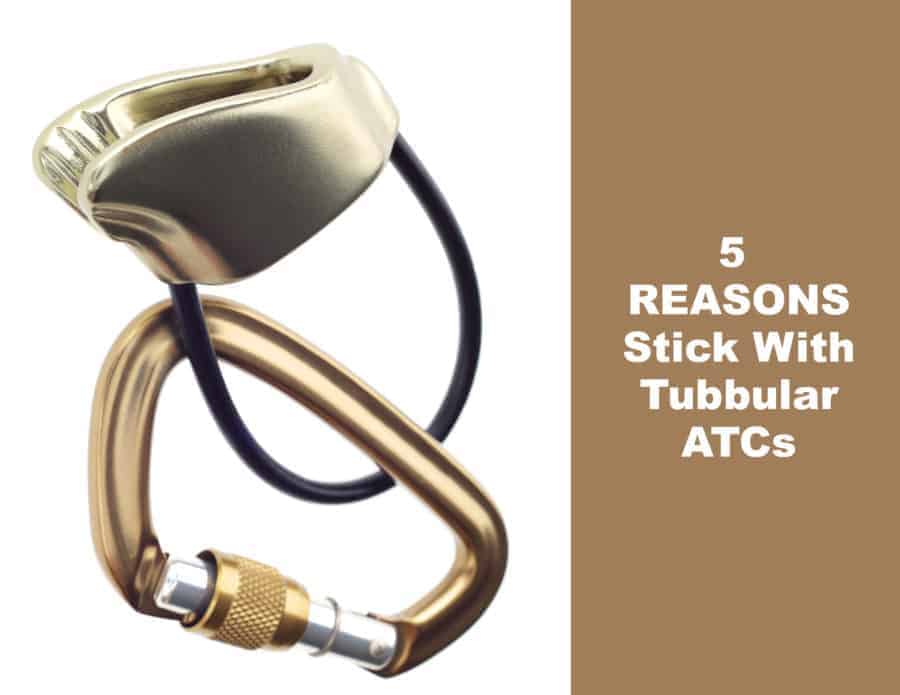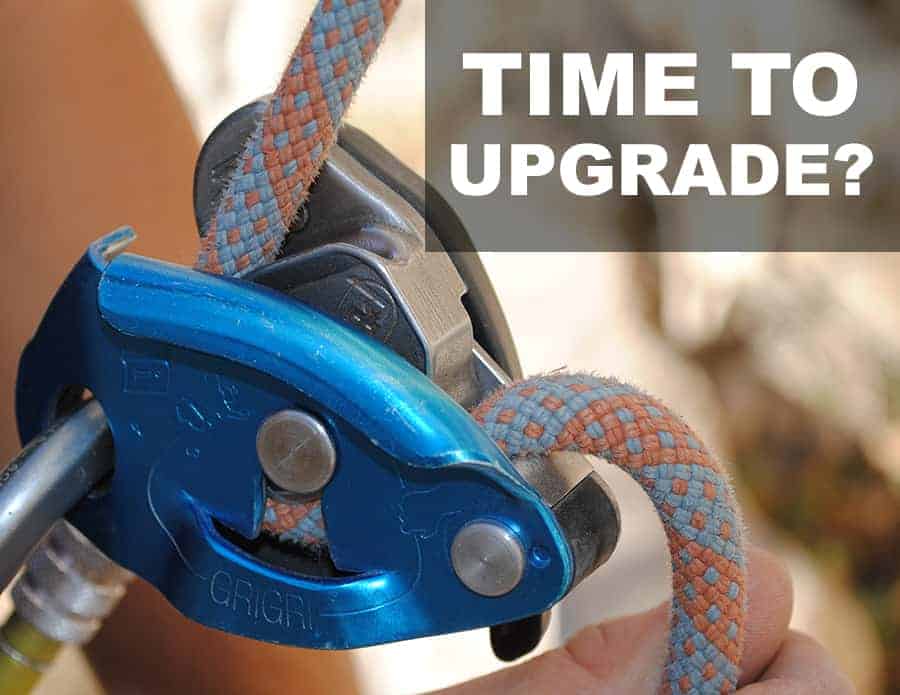In the first few years of climbing, I used an ATC and never considered spending additional money on an assisted-braking device. However, after witnessing a terrible climbing accident (not even related to an ATC), I realized that I needed gear that could minimize any risk involved in the dangerous sport of climbing.
Is an assisted braking belay device worth upgrading to? Every climber should use an assisted braking device while climbing indoors or outdoors.
This article outlines considerations for those who are wondering if they should upgrade from basic ATC belay devices to auto-locking belay devices. Including the different types of auto-locking (also known as assisted-breaking and auto-blocking) belay devices and how to use them. I’ve also provided 5 reasons to upgrade and 5 reasons to stick with a tubular ATC belay device.
If you don’t want to read the whole article, here is a quick summary:
Basic ATCs are the most common belay devices among climbers. However, they have the least amount of safety features when it comes to belaying devices. An ATC is essentially a metal device made of two tubes that hold the rope so that a belayer may control the speed rope is fed to and from the climber easier. If something happens to the belayer or if the belayer loses control of the rope then the climber risks falling. In comparison, a belay device that has auto-locking features would keep the climber safe.
For example, if a fall occurs and the belayer is pulled into the cliffside and becomes unconscious, the belay device will automatically stop the rope from moving through the device.
Types of Assisted-Braking Devices
There are two types of assisted-braking belay devices. This includes active and passive assisted braking. Depending on the device, assisted-braking/auto-blocking occurs by pinching the rope in a cam or by pinching the rope in the device itself. This is an important safety feature that can prevent critical injuries and/or death. Here is my favorite assisted-braking belay device (The Best Belay Device)
Active braking is when the device has a mechanical reaction in the cam system. Active braking devices also provide tools that can control the speed of the rope going through the device. This is an easy process in which, all you have to do is pull a lever. The further back you pull the lever, the faster the rope goes through the device.
Popular active-braking belay devices include GriGri+, Camp Matik, Edelrid Eddy and the Mad Rock Lifeguard.
Passive assisted-braking belay devices require the belayer to pinch the rope between the device and the rope to stop the rope from moving using friction. Typically they are lighter and less expensive. Some passive assisted-braking devices require additional hand strength to control the speed at which the rope is released.
Popular passive assisted-braking devices include Black Diamond ATC XP and Pilot, Mammut Smart 2.0, and the Petzl Verso.
If you consider upgrading to an assisted-braking device, you may be wondering what assisted-braking device you should upgrade to. To get all of the benefits of an assisted-braking device, you will need an active belay device. They are more expensive, but the ease of use and minimal strength needed to use it is worth the additional cost.
If you want to know what the best assisted-braking belay device is, check out this article (The Best Of The Best Belay Device).
5 Reasons To Upgrade
- Additional Safety: Assisted-braking belay devices have the added benefit of stopping the rope even when the belayer cannot. Climbing outdoors has an added risk of rocks falling on you or becoming incapacitated by being pushed against this cliffside. Because of this, it is important to be as safe as possible, including using assisted-braking belay devices.
- Peace Of Mind: When you are climbing, knowing that the belayer is using an auto-blocking belay device can help minimize fears of heights if you struggle with that fear. I have a climbing friend that has been working for years to get past his fear of heights while climbing and he said that when belayers use grigris or other assisted-braking devices he feels more comfortable climbing higher and harder.
- Easier To Let Climbers Down: With active assisted-braking belay devices, they contain levers or other ways to assist belayers with letting the climber down. For example, the Grigri, Trango Vergo, Edelrid Eddy, Mad Rock Lifeguard, and Camp Matik all have levers that help control the speed that the rope goes through the device while letting a climber down.
- Less Stress To Use: The stress that a belayer goes through can be significant if the climber is prone to falling. If a belayer is overstressed, they are more likely to make mistakes. Auto-blocking devices are less stressful to use because they can control the rope in case the belayer drops the rope.
- Helps Improve Your Climbing: Many climbers feel more comfortable taking risks and climbing harder when they know that the belayer is using an assisted-braking belay device. The more you take risks and push yourself, the more you improve your climbing.
How To Use Assisted-Braking Devices
Though the general use of the devices are similar, each device is made a little different. If you are concerned about learning how to use the device, ask a friend. It may be worth going to a climbing gym and asking someone if they can show you how to use it. There are videos online, but when it comes to the safety of a climber, in-person instruction is best.
I asked one of the employees at a climbing gym that I frequent to show me how to use my device and he was happy to instruct me on how to use it. (see the belay device I use here) It only took a couple of minutes to learn and remember how to use for top-rope belaying. It takes a little longer for lead-belaying. This is because lead belay requires taking and giving rope constantly.
Once you get used to belaying, it is important that you don’t get lazy. Some belayers have reported that they rely too much on the device and chat with other people while letting the climber down. It is still important to give your full attention to the climber – even if your device makes lowering a climber easier and stress-free.

5 Reasons To Stick With ATCs
Many climbers agree that assisted-braking belay devices are an important tool for climbing. However, some climbers feel that they should continue using the basic tubular ATC devices.
- Sign of OG Climber: Many new climbers use assisted-braking belay devices and using an ATC is a sign that you have been climbing before the new-wave of climbers began climbing.
- Safety Isn’t A Concern: Many climbers that decide to continue using a basic ATC belay device often feel confident that they can provide the safest belay, even if they become unconscious. However, becoming unconscious is one of the most unsafe things that can occur while belaying and one of the main reasons assisted-braking devices where designed.
- You have tried multiple assisted-braking belay devices in the past and don’t like them: The feel and use of assisted-braking belay devices are very different from a tubular ACT belay device. This may make you feel uncomfortable when learning to use it. If this is the case for you, then learn how to use the device from someone different. The person that you learn from can make a big difference in how you feel about it and learning from someone else may be worth it.
- The additional weight in an assisted-brakinging device: some climbers feel that every ounce of weight makes a difference when it comes to big wall climbing. Assisted-braking devices weigh more than tubular ATC devices. The weight is only a couple of ounces and unless you are competing, the weight isn’t noticeable.
- Assisted-braking belay devices cost more: Basic ATC devices can cost as low as $13 compared to assisted-braking devices can cost more than $60. This cost can be a big barrier and prevent climbers from upgrading.
Conclusion
Hopefully, this helps you understand whether or not upgrading to an assisted-braking device is best for you. Assisted-braking belay devices can be an important upgrade to the safety and continuation of your climbing experience. We upgraded to an active assisted-braking device (see which one here) and the peace of mind that we get from it has made it easier for us to climb harder and take more risks. Fortunately, this has resulted in improving our climbing skills as well.
Are you considering upgrading your belay device to assisted-braking? Perhaps you’ve used an assisted-braking device before, what did you think?
More Buyer’s Guides:
- The Top 5 Crash Pads For Bouldering: How To Decide Which Is Best
- Diy Hangboard With Jugs And Edges For Less Than $15
- 6 Of The Best Belay Devices For Beginner Climbers
- The Best 11 Climbing Shoes Under $100
- Climbing Chalk: Chunky Vs. Fine
- The Best Chalk For Climbing And Bouldering
- Rock Climbing Starter Kits For Beginners Compared
- Liquid Chalk Vs. Dry Chalk For Bouldering (Hint: Dry Chalk Is Better)
- Top 5 Gear You Need In Your Climbing Pack For The Best Experience
- What To Wear While Bouldering
- Should You Upgrade To An Assisted-Braking Belay Device?
- Everything You Need To Know About Climbing Chalk
- 37 Things Serious Climbers Bring With Them To The Mountains
- Clothing For Climbing In The Gym – What Should You Wear?
- Can You Climb Without Chalk?
- How Tight Climbing Shoes Should Fit For The Best Performance
- Harnesses For Rappeling
- My Favorite Harness For Climbing
- What You Should Wear While Climbing
- What Affects How Climbing Shoes Fit?
- How To Clean Your Grigri
- How To Care For Your Climbing Rope


